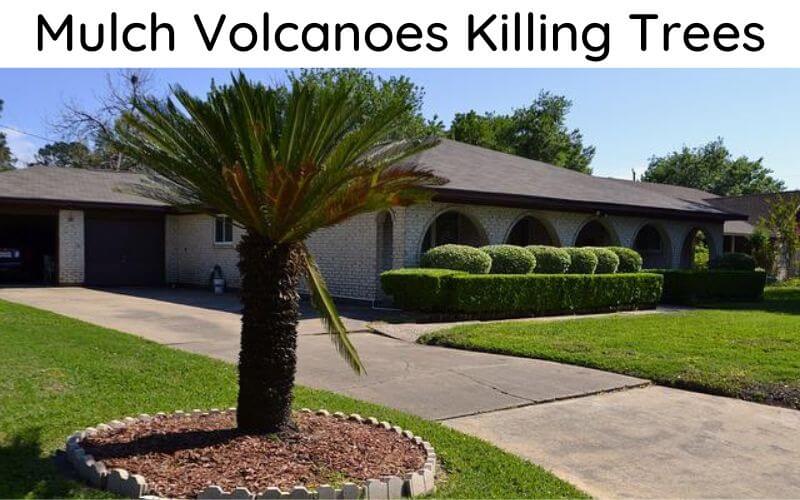Yes, mulch volcanoes are fatal to trees. The mulch that has piled up over the years suffocates the tree and deprives it of crucial resources. The tree becomes more susceptible to insect/pathogen attack.
If done properly, mulching helps the trees. Mulching can prove fatal to trees if done improperly. Mulch volcanoes kill trees but many aren’t aware of this.
Mulch inhibits weeds, retains soil moisture, and enriches the soil as it decomposes. A circle of mulch also protects the tree from lawn mowers and string trimmers.
Mulch gives your landscape a neat, manicured look. In this article, you’ll learn what happens when mulch piles up around a tree.
Mulch too high around trees?
A lot of problems arise when the mulch around the tree is higher than needed. Mulch piles up over the years and this poses a threat to the tree. Don’t let the mulch layer grow taller than 3 inches.
Does Mulch suffocate trees?
Yes, a lot of mulch suffocates trees. If there’s too much mulch around the tree, the roots start growing upwards and into the mulch rather than into the ground.
The roots do this in search of air. These roots form a girdle around the trunk of the tree, choking the basal part of the stem.
At this point, the water doesn’t go into the main trunk of the tree. The excess moisture remains in the roots and builds up slowly near the base of the tree.
The deteriorating bark at the base of the tree leads to an unstable foundation.
How high should mulch be around trees?
The mulch layer around a tree shouldn’t be more than 2-4 inches, making sure that the mulch doesn’t touch the tree.
If the mulch layer is too high it forms a ‘volcano’ around the tree. Most gardeners call it the volcano as it could prove fatal to the tree.
Why is Volcano mulching bad?
Volcano mulching suffocates the tree. The pile of mulch interferes with the water transport to the main trunk of the tree.
Not only this but the mulch volcano can create a variety of problems, some of which are fatal to the tree. Let’s see what they are.
Covers the root flare
Properly grown trees possess root flare. The root flare is where the first main roots attach to the trunk. Mulch volcano covers the root flare.
The root flare is an important junction and it acts as a bridge between the trunk and the root system. You don’t wanna cover it with damp organic substance.
Piles of damp mulch interfere with root development. The roots fail to grow deeply into the soil as moisture is easily available in the top layers of the soil.
This causes problems when there are drought conditions. The tree won’t be able to absorb enough water to fulfill its needs.
Stem girdling roots
The roots don’t grow into the ground as the water is readily available in the top layer. Instead, roots arise from the trunk that girdle the tree.
These roots grow around the tree, eventually merging with the trunk tissue. Such roots increase in size after a while and choke the tree trunk.
This ‘girdle’ inhibits the water supply to the trunk. This is the reason why they are called ‘stem girdling roots’.
Pathogens and Pests attack the tree easily
Excess moisture in the mulch is not an ideal condition. This damp mulch causes cracks in the bark at the base of the tree.
A variety of fungal pathogens take advantage of these cracks to attack the tree. They can’t do that normally due to the thick bark.
Apart from fungal pathogens, a variety of insects also eat away at the trunk through these cracks. Rodents can also attack the tree if such cracks are present in the tree.
Decomposed mulch is dangerous!
Decomposed mulch produces a lot of heat. This heat damages the bark and the underlying tissue that helps transport water and minerals. Decomposed mulch also repels water thanks to its hydrophobic nature.
Decomposed mulch provides a hideout to a variety of insects. These insects pose a danger to the tree especially as the cracks appear on the trunk.
As the mulch decomposes and dries out it becomes hydrophobic. So, aged mulch volcanoes start repelling water, as a result, the roots don’t get enough water.
How to mulch a tree properly?
Mulching is a crucial aspect of landscaping. Mulching can benefit the tree if done properly. Always use organic mulch like wood chips/bark.
Many people improperly mulch their trees. This leads to a lot of problems. This might look good but it could prove fatal to the tree.
People tend to over-do mulching, leading to mulch volcanoes. Let’s answer the common queries around mulching.
Should mulch touch the tree?
No, don’t let the mulch touch the tree trunk. The trunk should always stay dry. Anything that keeps it damp for a long period is harmful to the tree.
Make sure you start mulching 4-6 inches away from the tree trunk. The root flare should be visible after you’re done mulching the tree.
How big should the mulch ring around a tree be?
You need to spread the mulch around the tree such that the ring has a radius of 3-4 feet from the tree. You need to leave 3-4 inches around the tree as we discussed before.
The mulch layer should be spread out to prevent the formation of a volcano.
How deep should mulch be around trees?
The depth of the mulch layer shouldn’t exceed 3 inches. A deep layer of mulch hurt the tree, so don’t let it exceed 3 inches. Don’t let the depth exceed the heel of your hand.

